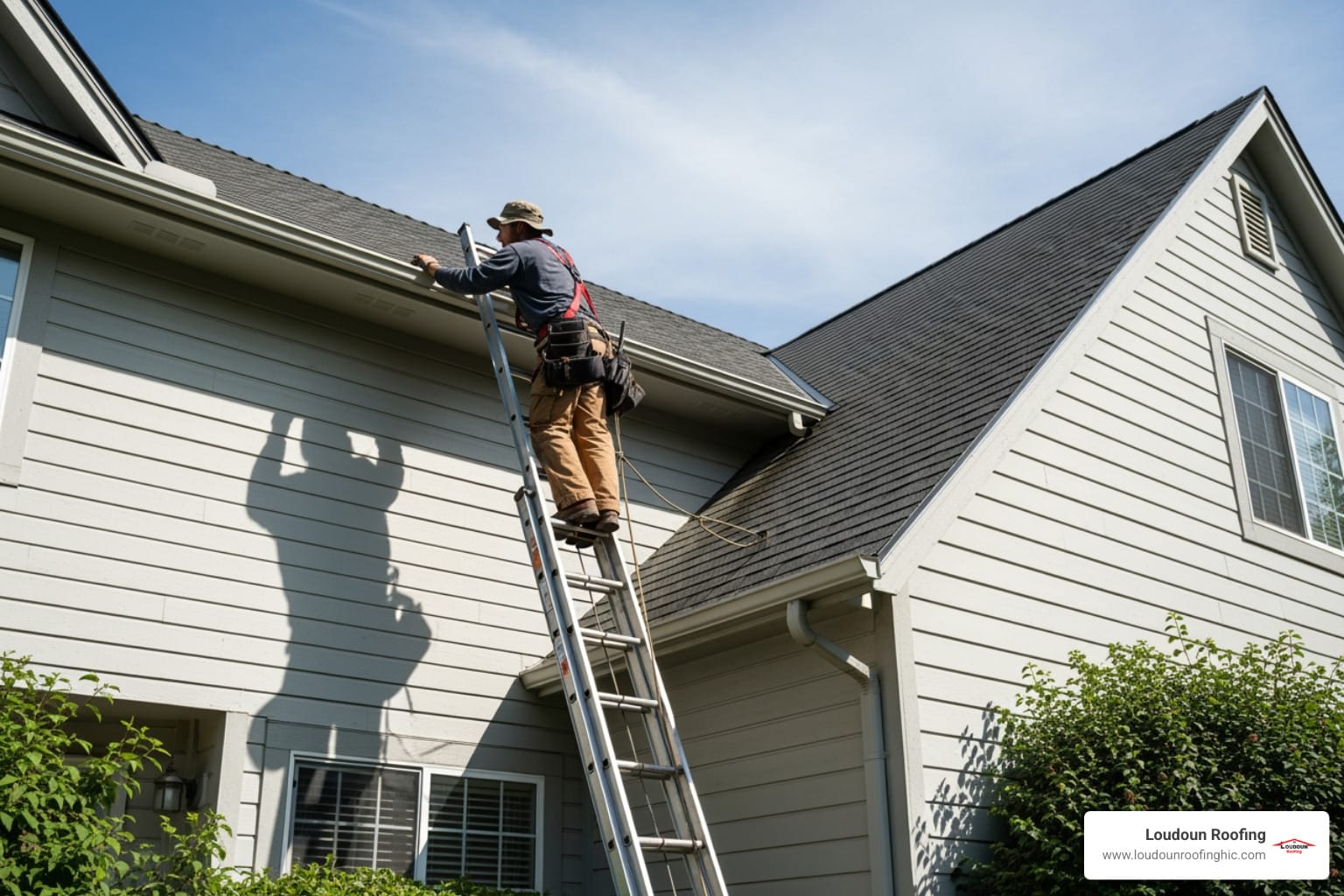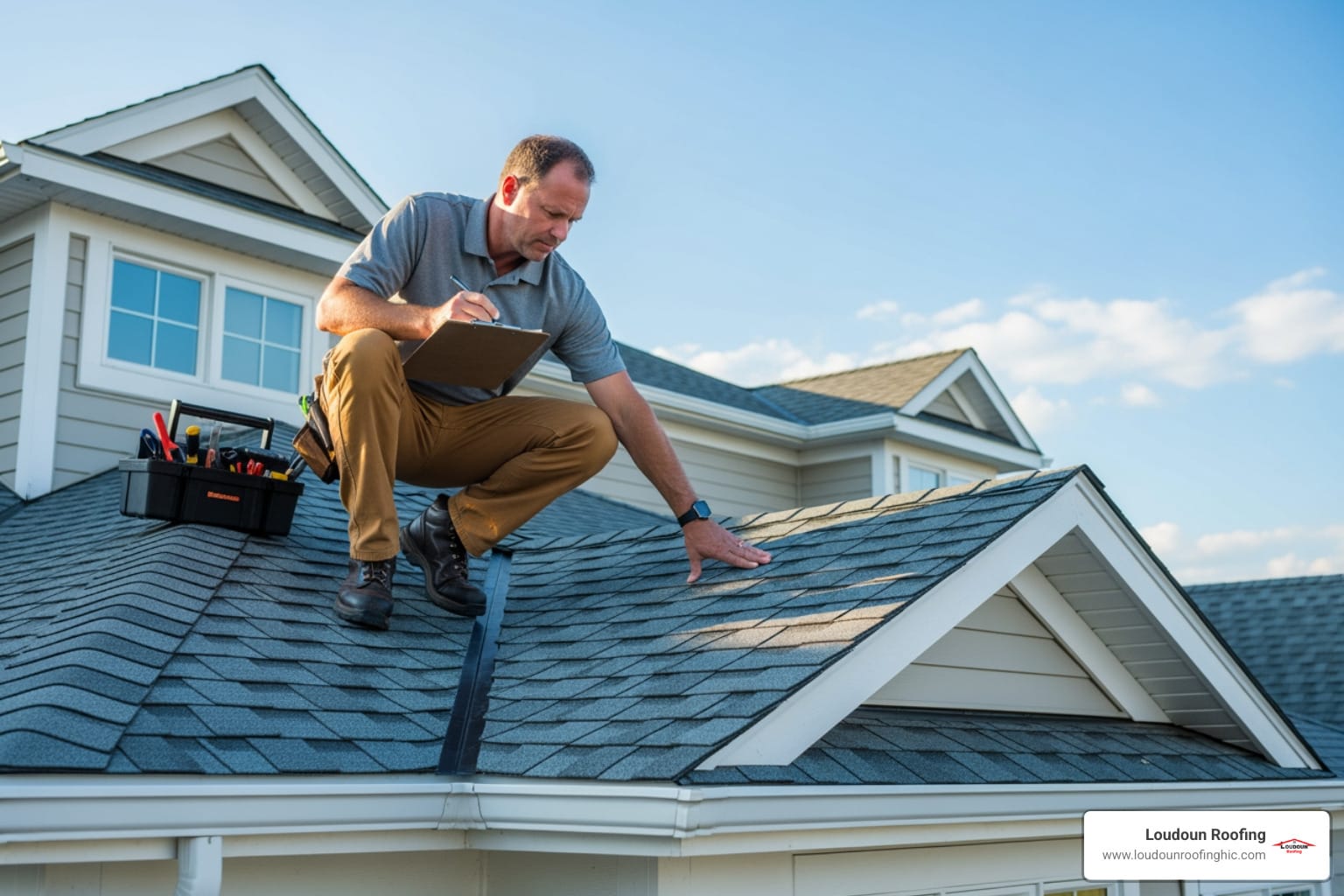Why Storm Damage Assessment Is Your First Line of Defense
After a severe storm, relief can quickly turn to concern about your home. A storm damage assessment is the systematic process of evaluating property damage to determine the extent of harm and necessary repairs. This critical first step is your best defense, helping you document losses for insurance and prioritize safety. For homeowners in Northern Virginia, understanding how to get a professional storm damage assessment is crucial for protecting your family and securing resources for proper repairs.
Quick Overview: Storm Damage Assessment Process
- Ensure Safety – Check for hazards like downed power lines or structural damage.
- Document Everything – Take photos and videos of all visible damage.
- Contact Insurance – Report damage within your policy’s time limits.
- Get Professional Help – Hire qualified contractors for a thorough evaluation.
- Understand Official Processes – Learn how FEMA’s Preliminary Damage Assessment works.
Storms cause billions in property damage annually in the U.S., and much of it—from missing shingles and hail dents to water intrusion—isn’t immediately visible to the untrained eye. The assessment process involves your initial safety check, documentation, and official evaluations by insurance adjusters and potentially FEMA. A thorough evaluation ensures nothing is overlooked during this critical time.
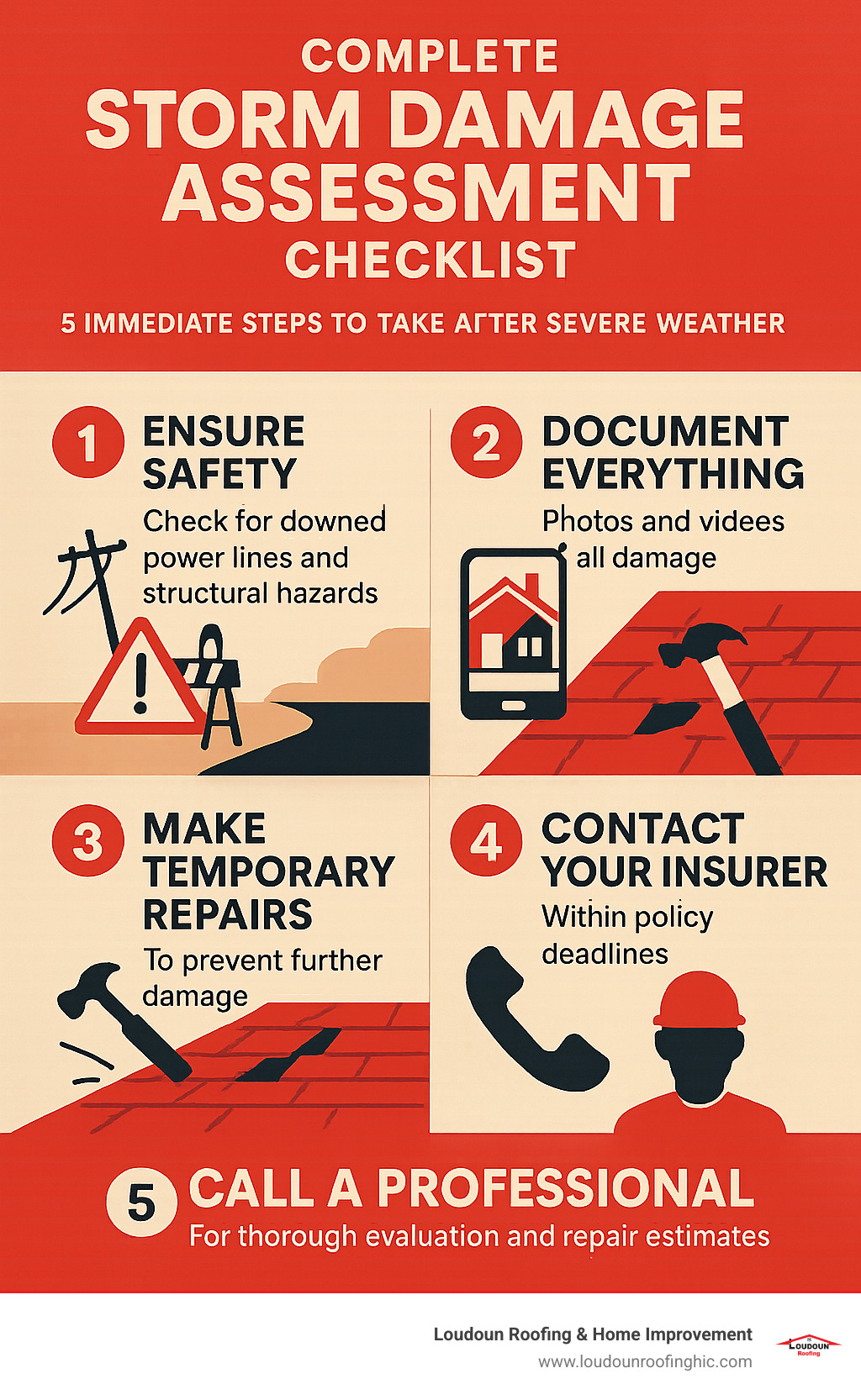
Your Role: Conducting an Initial Home Inspection
Once authorities give the all-clear, prioritize safety first. Scan for downed power lines, gas leaks, or unstable structures before proceeding. When it’s safe, you can begin your own initial storm damage assessment, starting outside and working your way in. You’re simply documenting what’s visible.
Common damage types include wind damage (missing shingles or siding), hail damage (dark bruises on asphalt shingles), water damage (ceiling stains, musty smells), and impacts from fallen debris. Pay special attention to your roof, checking for missing shingles and an accumulation of granules in your gutters. Exterior damage can include dented siding or cracked stucco. For windows, look for both shattered glass and hairline cracks. Inside, water stains or sticking doors can signal water intrusion or structural shifts. Don’t forget to check your attic and basement, as these areas often show the first signs of trouble.
For homeowners dealing with one of Virginia’s most common storm challenges, our detailed guide on How to Spot Hail Damage on Your Roof: A Complete Guide for Homeowners in Loudoun County, VA provides the specific insights you need.
How to Document Storm Damage Effectively
Think of yourself as building a case for your insurance claim. The more thorough your documentation, the smoother your recovery process will be.
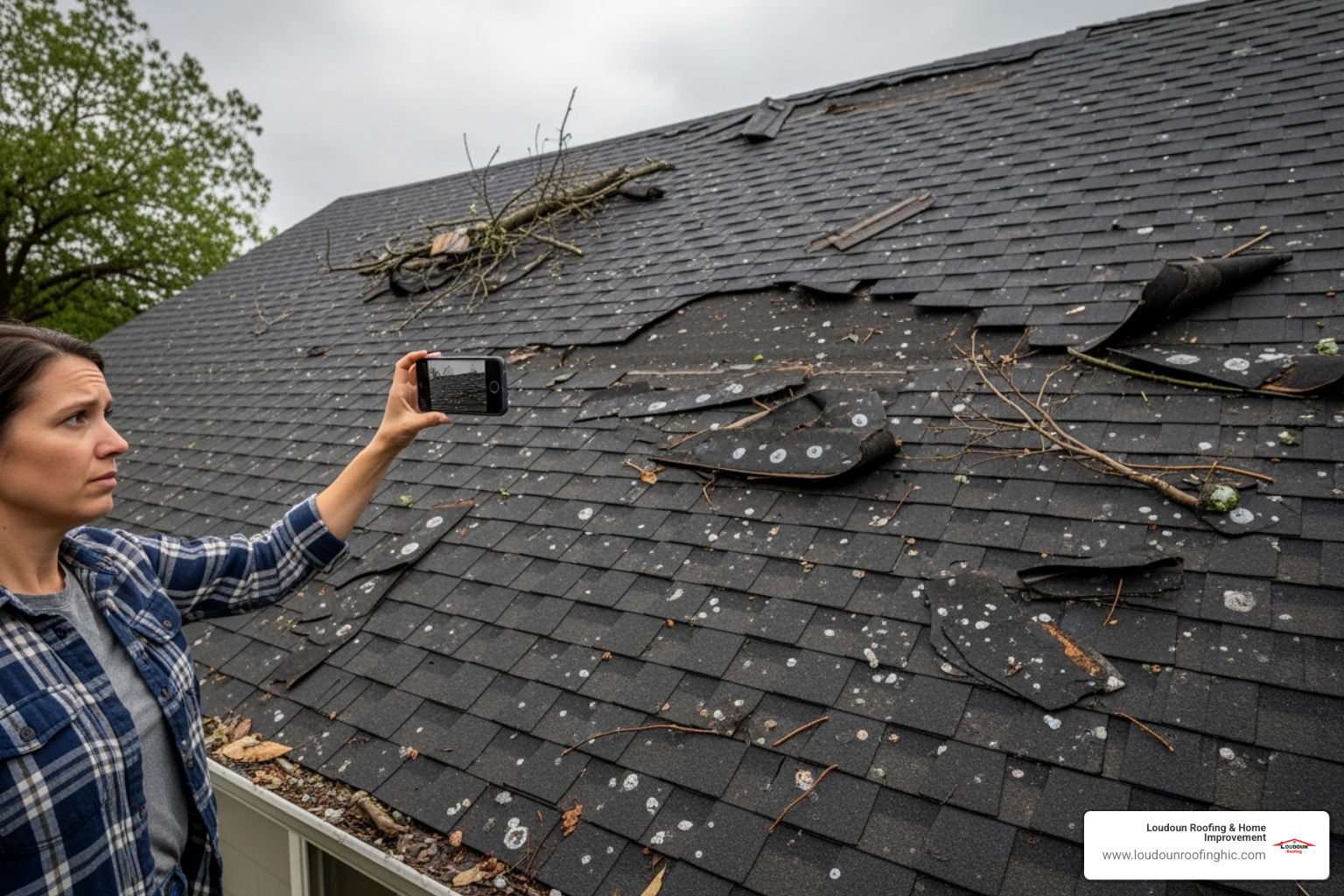
- Photo and Video: Take clear shots from multiple angles, capturing both close-up details and wider context. A video walkthrough where you narrate what you see is invaluable for insurance adjusters.
- Written Logs: Note every damaged item, its approximate age and value, and when you noticed the damage. Use date and time stamps on all your documentation.
- Receipts: Keep every receipt for temporary repairs (like tarps) or other storm-related expenses, as they may be reimbursable.
- Organization: Create clearly labeled digital and physical folders to save headaches later. A file named “Roof-Damage-West-Side-2024-05-15.jpg” is easy to find months later.
Identifying Common Types of Storm Damage
Recognizing damage patterns helps you communicate effectively with insurance adjusters and contractors.
- Wind Damage: Often widespread, it can rip off shingles, loosen siding, and turn branches into projectiles. Winds of 50-60 mph can cause visible roofing damage.
- Hail Damage: Creates distinctive bruises on asphalt shingles where protective granules are knocked away. It also leaves dents on siding and can crack windows.
- Water Damage: Can be insidious, starting small and growing into major problems like mold, wood rot, and structural issues.
- Fallen Debris: Ranges from minor scratches to catastrophic structural damage from falling trees. Be extremely cautious around any downed power lines near fallen trees.
- Tornado Damage: The most severe type, rated on the Improved Fujita (EF) Scale from EF0 (65-85 mph winds) to EF5 (over 200 mph winds). This scale helps classify the forces involved for insurance and disaster aid purposes.
Our team specializes in addressing all types of Storm & Hail Damage to help Virginia homeowners recover quickly. You can also Learn about the EF Scale from the National Weather Service to better understand how tornado damage is assessed.
Understanding the Official Process: The Preliminary Damage Assessment (PDA)
While you assess your own property, a much larger evaluation may be happening behind the scenes. When storms cause widespread damage, FEMA works with state and local officials to conduct a Preliminary Damage Assessment (PDA).
This official investigation determines if your community qualifies for federal disaster assistance. The PDA’s purpose is to gather enough data to justify a Major Disaster Declaration from the President. This declaration open ups federal resources, including Public Assistance (PA) for infrastructure like roads and public buildings, and Individual Assistance (IA) for homeowners and families. This process is a crucial step that determines whether federal support flows to affected areas.
For a closer look at how this works, FEMA offers helpful resources. You can Watch a video series on the PDA process to see how these assessments unfold in real-world disaster situations.
What is a Preliminary Damage Assessment (PDA)?
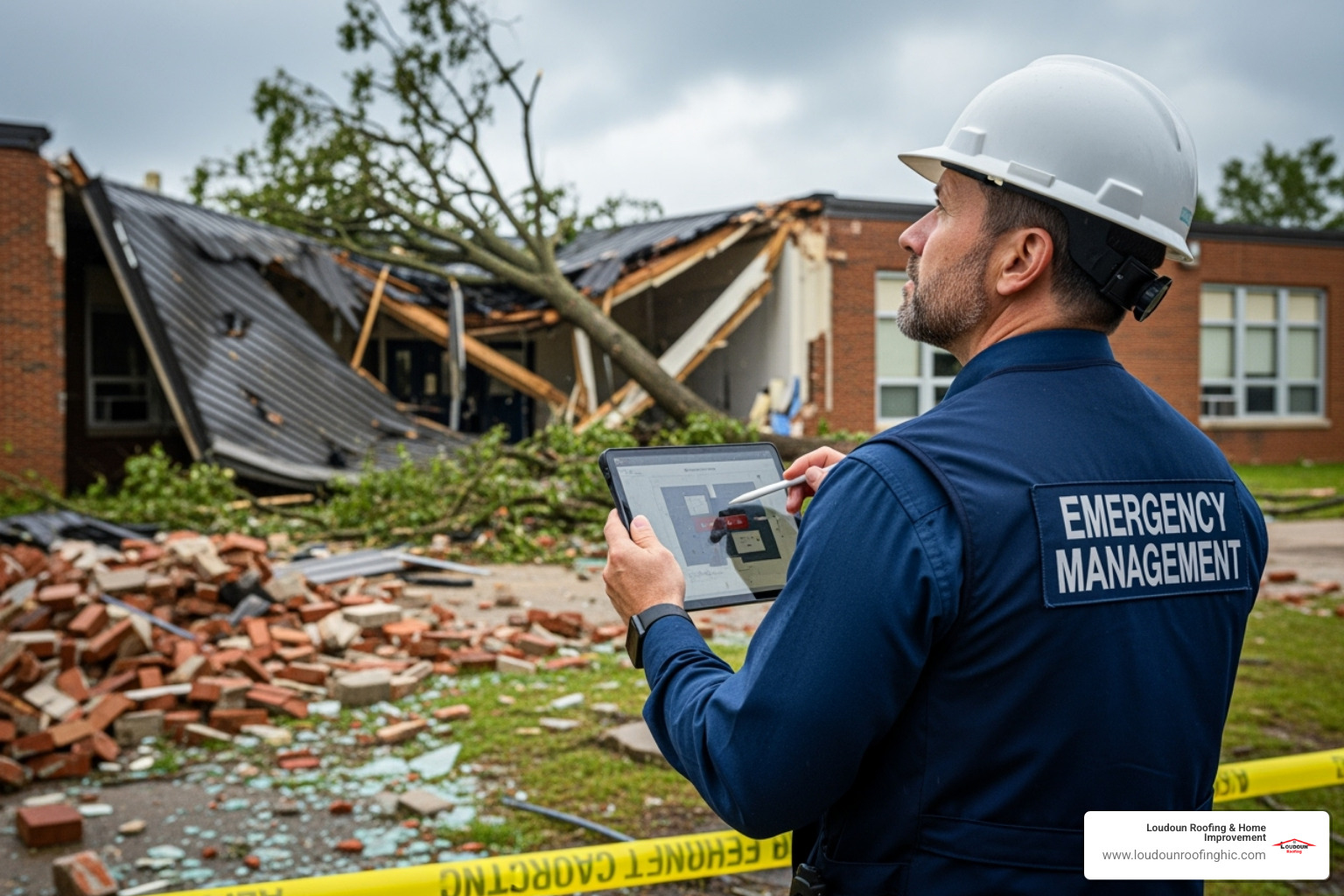
A Preliminary Damage Assessment is a rapid evaluation conducted by joint assessment teams from FEMA, state emergency management, and local government. These teams move quickly, focusing on data collection that captures the overall scope of destruction.
They document how many homes were destroyed versus damaged, which major roads are impassable, and whether critical infrastructure like hospitals or schools were hit. A major part of their work is estimating costs for both public infrastructure and private property losses. All of this information is used for justifying federal aid by demonstrating that the damage exceeds what local and state resources can handle alone.
A PDA provides a high-level view, whereas a detailed assessment from an insurance adjuster or contractor zooms in on specific repair costs for an individual property. Both are essential but serve different purposes.
How FEMA Uses PDA Reports
Once completed, PDA reports become powerful tools that shape the disaster response. They serve as the disaster declaration trigger, providing the evidence FEMA needs to recommend a Major Disaster Declaration to the President.
If a declaration is approved, the PDA data helps inform recovery programs, allowing federal agencies to tailor assistance to the community’s specific needs. The reports also guide the allocation of resources by identifying the hardest-hit areas that require immediate attention. For public transparency, FEMA makes these reports available online, typically about 30 days after a decision is made. You can Access PDA Reports for specific disasters to see how officials evaluated damage in various communities.
The Modern Approach: Technology in Storm Damage Assessment
The world of storm damage assessment has been transformed by technology, making the process faster, more accurate, and significantly safer.
GIS technology allows emergency managers to visualize where damage occurred and deploy resources strategically. Field teams use mobile apps like ArcGIS Survey123 to collect detailed information on phones or tablets, even when offline. Drones have revolutionized aerial inspections by providing crystal-clear views of rooftops and other areas that are dangerous or impossible to reach safely. At the same time, satellite imagery gives a big-picture view for large-scale disasters.
The real magic happens with real-time data visualization through tools like ArcGIS Dashboards. Decision-makers can watch damage reports flow in live, spot trends, and allocate resources based on actual data. The results are increased accuracy and faster assessments, with FEMA now able to cut evaluation times from days to just hours in many cases.
The Role of Drones and GIS in Your Personal Assessment
While government agencies use these tools for large-scale response, the technology is also incredibly valuable for individual homeowners and professional contractors.
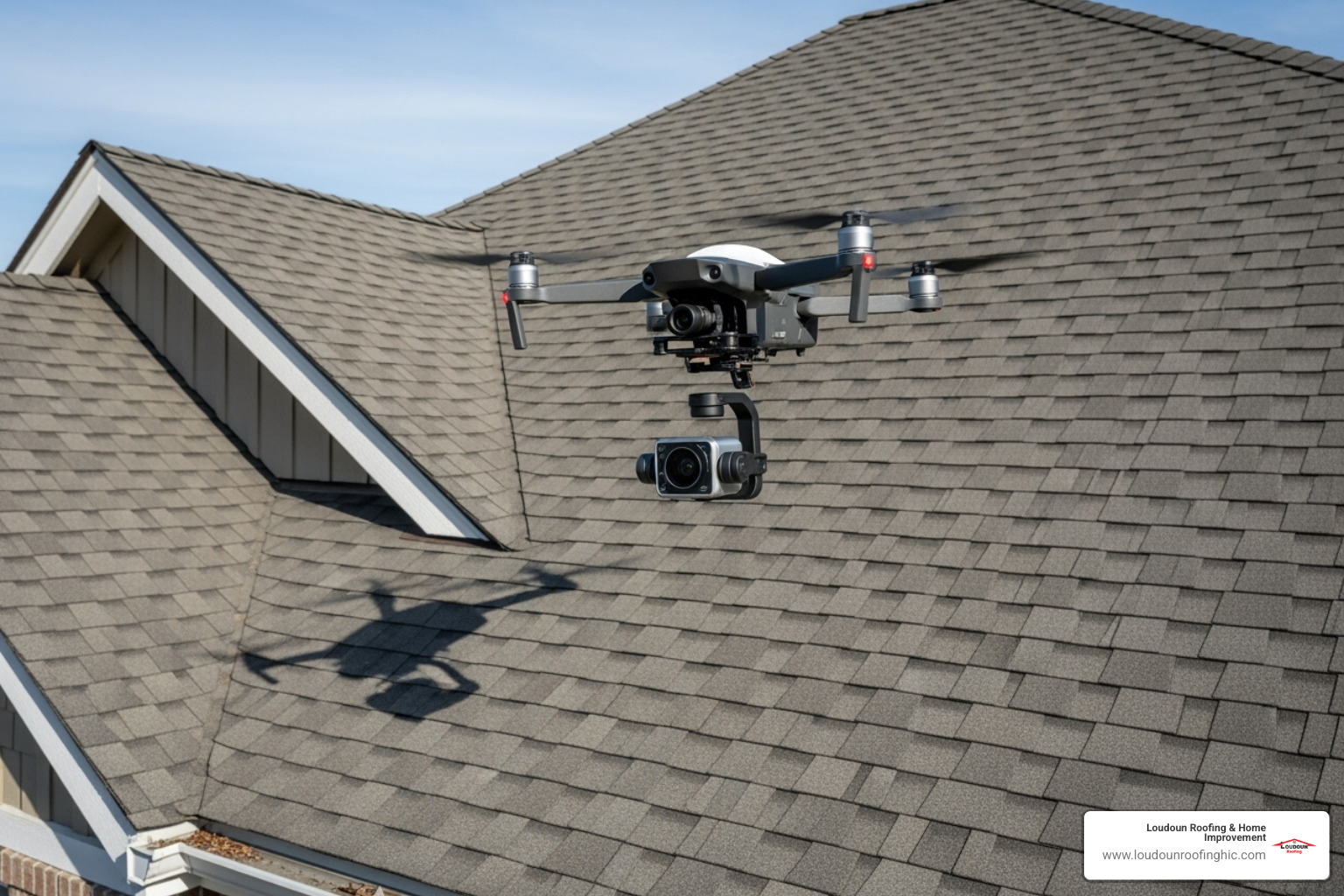
Climbing onto a damaged roof is dangerous. Drones eliminate this safety risk, allowing for a thorough aerial inspection from the ground. The high-resolution imagery they capture can spot subtle hail dents or lifted shingles that are nearly invisible otherwise. This detailed documentation, which can include 3D models of your roof, helps identify hidden damage in hard-to-reach areas.
When it comes to insurance claims, high-quality drone imagery provides undeniable visual evidence that can significantly streamline the process. Adjusters appreciate detailed documentation, and clear aerial footage helps ensure you receive a fair settlement without lengthy disputes.
Navigating Repairs and Insurance
Once your storm damage assessment is complete, you face two major tasks: working with your insurance company and hiring the right contractor. It can feel overwhelming, but a methodical approach helps.
Report damage to your insurer promptly, as most policies have strict deadlines. Your homeowner’s insurance is your primary resource for covered damages. FEMA assistance is a safety net for uninsured or catastrophic losses, not a replacement for insurance. Be wary of “storm chasers”—out-of-state contractors who offer quick, cheap fixes and then disappear. Always stick with local, established contractors who have roots in your community. For a deeper dive into the insurance side of things, check out our guide on Roof Insurance Claims Explained.
Best Practices for Hiring a Storm Damage Contractor
The difference between a reputable contractor and a storm chaser can make or break your recovery. Here’s how to tell them apart:
| Feature | Reputable Local Contractor | “Storm Chaser” |
|---|---|---|
| Local Presence | Established office, references in your community. | No local office, moves quickly from disaster to disaster. |
| Licensing & Insurance | Fully licensed, carries liability and worker’s comp. | Often unlicensed or operates under a temporary license. |
| Written Contract | Detailed, clear scope of work, materials, timeline, cost. | Vague, handwritten, or high-pressure verbal agreements. |
| References | Happy local customers, willing to provide contact info. | Few or no local references, vague testimonials. |
| Sales Tactics | Professional, informative, no pressure. | High-pressure, door-to-door, urgent, “limited-time” offers. |
| Deductible Offers | Will NOT offer to pay your deductible (illegal in VA). | May offer to “cover” or “waive” your deductible. |
| Warranty | Offers clear, written warranties on work and materials. | No clear warranty, or difficult to enforce later. |
Always verify credentials like licensing and insurance. Demand a detailed written contract that spells out the scope of work, materials, and costs. Ask for local references and beware of high-pressure sales tactics. Crucially, never work with a contractor who offers to waive your insurance deductible, as this is illegal in Virginia and could be considered insurance fraud.
Your Insurance Claim vs. FEMA Assistance
Understanding the difference between these two resources is key.
- Your insurance policy is always your primary source of recovery funds. It is designed to restore your property based on your specific coverage.
- FEMA assistance fills the gaps that insurance doesn’t cover, such as for uninsured losses or when damages exceed policy limits. It is not meant to replace insurance.
- Assessment criteria are different. Your insurance adjuster focuses on your specific policy, while FEMA assesses the overall disaster impact on the region.
- Thorough documentation helps with both processes. The photos, videos, and notes you take are vital for your insurance claim and any potential FEMA application.
Frequently Asked Questions about Storm Damage Assessment
After helping hundreds of Northern Virginia families with their storm damage assessment challenges, we’ve noticed the same questions come up time and again. Here are the answers that matter most.
How long do I have to file an insurance claim after a storm?
This is an urgent question, and the answer varies. Your insurance policy is the primary source, with deadlines ranging from a vague “reasonable time” to strict 30, 60, or 90-day limits. Virginia state regulations can also affect your timeline. Our strongest advice is to act promptly. Don’t wait. Delays can give an insurer reason to argue that further damage occurred on your watch. Report the damage to your agent immediately, even if you don’t know the full extent yet.
What if my insurance adjuster’s estimate is lower than my contractor’s?
This is a common scenario. Your first step should be to request a re-inspection and have your contractor present to discuss the damage with the adjuster. Provide your contractor’s detailed, line-item estimate to the adjuster so they can compare specifics. If you’re still at an impasse, your policy likely includes an independent appraisal clause, which brings in a neutral third party to evaluate the costs. A good contractor will explain every line item so you can advocate for yourself effectively.
Can I start repairs before the assessment is complete?
This requires some nuance. You should absolutely wait for your insurance adjuster’s storm damage assessment before starting any permanent repairs, as doing so can complicate your claim. However, temporary repairs are not just allowed—they’re expected. Your policy requires you to take reasonable steps to prevent further damage, such as tarping a damaged roof or boarding up broken windows. The critical part is to document pre-repair conditions thoroughly with photos and videos before you touch anything. Keep every receipt for materials. When in doubt, call your agent first.
Your Partner in Storm Recovery
When the storm clouds clear and the immediate danger passes, the real work begins. A thorough storm damage assessment sets the foundation for everything that follows, from insurance claims to finding the right contractor for repairs. This process doesn’t have to feel overwhelming when you know what steps to take.
By staying organized, documenting everything, and understanding the roles of your insurer and FEMA, you can steer the process confidently. Most importantly, choosing the right contractor makes all the difference in your recovery experience. Local, licensed professionals who understand Virginia’s building codes and weather patterns will serve you far better than fly-by-night storm chasers who disappear as quickly as they arrived.
For a professional and thorough storm damage assessment in Great Falls and throughout Northern Virginia, trust the experienced team at Loudoun Roofing & Home Improvement. We’ve been helping families recover from storm damage since 2001, combining old-fashioned craftsmanship with modern assessment technology.
Contact us today for a comprehensive evaluation that gives you the complete picture of your home’s condition. We’re here to guide you through every step of the recovery process.


